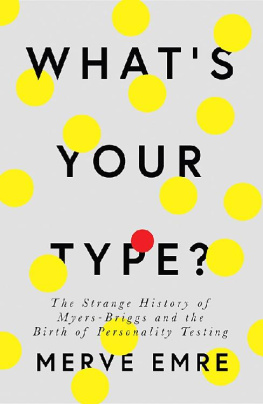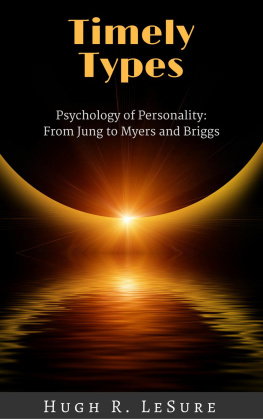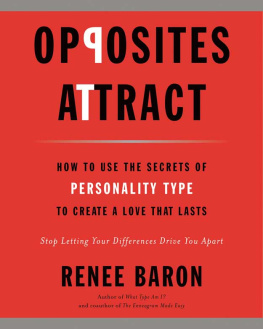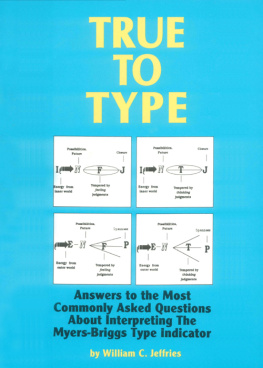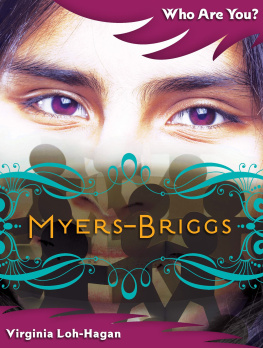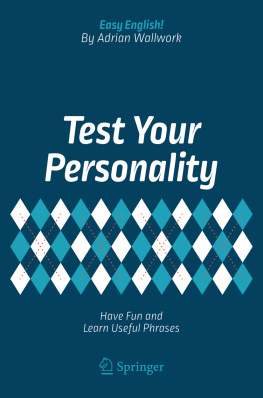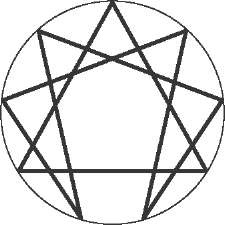Merve Emre - What’s Your Type?: The Strange History of Myers-Briggs and the Birth of Personality Testing
Here you can read online Merve Emre - What’s Your Type?: The Strange History of Myers-Briggs and the Birth of Personality Testing full text of the book (entire story) in english for free. Download pdf and epub, get meaning, cover and reviews about this ebook. year: 2018, publisher: HarperCollins Publishers, genre: Non-fiction. Description of the work, (preface) as well as reviews are available. Best literature library LitArk.com created for fans of good reading and offers a wide selection of genres:
Romance novel
Science fiction
Adventure
Detective
Science
History
Home and family
Prose
Art
Politics
Computer
Non-fiction
Religion
Business
Children
Humor
Choose a favorite category and find really read worthwhile books. Enjoy immersion in the world of imagination, feel the emotions of the characters or learn something new for yourself, make an fascinating discovery.
- Book:What’s Your Type?: The Strange History of Myers-Briggs and the Birth of Personality Testing
- Author:
- Publisher:HarperCollins Publishers
- Genre:
- Year:2018
- Rating:4 / 5
- Favourites:Add to favourites
- Your mark:
What’s Your Type?: The Strange History of Myers-Briggs and the Birth of Personality Testing: summary, description and annotation
We offer to read an annotation, description, summary or preface (depends on what the author of the book "What’s Your Type?: The Strange History of Myers-Briggs and the Birth of Personality Testing" wrote himself). If you haven't found the necessary information about the book — write in the comments, we will try to find it.
History that reads like biography that reads like a novel a fluid narrative that defies expectations and plays against type New York Times
This is a sparkling biography not of a person, but of a popular personality tool Adam Grant
An unprecedented history of the personality test conceived a century ago by a mother and her daughter fiction writers with no formal training in psychology and how it insinuated itself into our boardrooms, classrooms, and beyond.
The Myers-Briggs Type Indicator is the most popular personality test in the world. It has been harnessed by Fortune 100 companies, universities, hospitals, churches, and the military. Its language of extraversion vs. introversion, thinking vs. feeling has inspired online dating platforms and Buzzfeed quizzes alike. And yet despite the tests widespread adoption, experts in the field of psychometric testing, a $500 million industry, struggle to account for its success no less validate its results. How did the Myers-Briggs insinuate itself into our jobs, our relationships, our internet, our lives?
First conceived in the 1920s by the mother-daughter team of Katherine Briggs and Isabel Briggs Myers, a pair of aspiring novelists and devoted homemakers, the Myers-Briggs was designed to bring the gospel of Carl Jung to the masses. But it would take on a life of its own, reaching from the smoke-filled boardrooms of mid-century New York to Berkeley, California, where it was honed against some of the 20th centurys greatest creative minds. It would travel across the world to London, Zurich, Cape Town, Melbourne, and Tokyo; to elementary schools, nunneries, wellness retreats, and the closed-door corporate training sessions of today.
Drawing from original reporting and never-before-published documents, Whats Your Type? examines nothing less than the definition of the self our attempts to grasp, categorise and quantify our personalities. Surprising and absorbing, the book, like the test at its heart, considers the timeless question: What makes you you?
Merve Emre: author's other books
Who wrote What’s Your Type?: The Strange History of Myers-Briggs and the Birth of Personality Testing? Find out the surname, the name of the author of the book and a list of all author's works by series.

